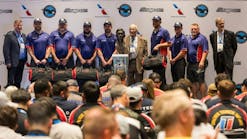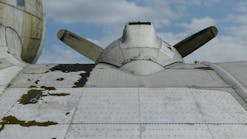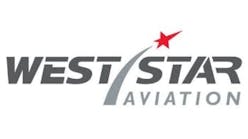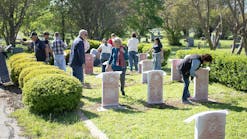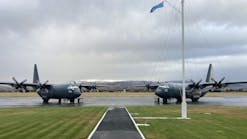Two World War II bombers flew into Waterbury-Oxford Airport Friday afternoon, but three more historic aircraft were not able to depart Trenton, N.J., because of heavy weather from Hurricane Dorian.
The B-17G Flying Fortress and B-24J Liberator that arrived Friday are examples of the most common bombers Army pilots flew against Germany from bases in England and Italy during World War II. Both bomber types also flew in the Pacific theater.
The two heavy bombers were to be joined Friday by a B-25 Mitchell medium bomber and two fighters, a P-40 Warhawk and a P-51 Mustang. They are expected to arrive at Waterbury-Oxford Airport sometime Saturday.
Among those on hand Friday afternoon to watch the bombers arrive was Walt Hushak, 95, of Southington, who flew B-24s against Japanese targets in the Pacific. Hushak was one of the Army aviators to bomb Iwo Jima before the Marines stormed ashore in February 1945.
“Terrific,” Hushak said as he examined the Liberator shortly after it landed at Waterbury-Oxford. “That bird is still flying.”
There’s a good-natured rivalry between B-17 and B-24 pilots. Although B-24s were faster, could fly further and carry more bombs, the B-17s got most of the attention and glory.
Laura Sorensen and her husband Stephen Graseck, of Southington, visited the airport to get a closeup view of the bombers.
“My dad flew in the B-24,” she said. He was a bombardier in the Eighth Air Force, based in England, and flew 35 missions against German targets.
“This is my only chance to see what it was like for him. It’s cramped in there, and narrow.”
Sorensen said her father told stories of his time during the war, but she’d never seen the aircraft he flew before. One of her father’s duties, she said, was to destroy the top secret Norden bomb sight in the bomber’s nose if the airplane was crashing or landing in enemy territory.
“You practically have to crawl to get from one part of the airplane to the other,” she said, adding her father described having to crawl from the bombardier’s position in the front of the airplane to the rear to aid a crewmen who had been badly wounded. The airman was not responding to calls over the bomber’s intercom, she said. When her father found the man, he was bleeding badly and her father saved the man’s life.
Sorensen said her mother had no idea about her father’s efforts that day until she received a letter from the wounded airman’s grateful mother a year later.
“It’s fascinating to look inside,” she said after stepping from the B-17. “Luckily my dad was a little, skinny guy.”
Nicholas DeNote, 7, of Terryville, was one of the younger people on hand to take in the bombers. He was ecstatic as he watched the B-24 land and then taxi to the tarmac outside Atlantic Aviation. He loves airplanes, builds model airplane and plans to be a pilot one day.
The B-25 bomber flew in Europe and the Pacific and was the type of aircraft used in the Doolittle Raid in 1942, when Army pilots flew off the aircraft carrier Hornet and bombed Tokyo and other targets. The raid was made famous in the book and movie “Thirty Seconds Over Tokyo,” starring Spencer Tracy as Col. Jimmy Doolittle.
The P-40 was made famous by the Flying Tigers, American fighter pilots who fought for the Chinese against the Japanese. The airplane continued in service later into World War II.
The P-51 Mustang was the premier Army fighter of World War II and had the range to escort bombers deep into Europe for attacks on German cities and industrial centers. The Collings Foundation P-51 is painted to represent a West Virginia Air National Guard aircraft. The West Virginia Air Guard was the last Air Force squadron to fly P-51s and retired its Mustangs in January 1957.
The airplanes will be open from 9:30 a.m. to 5 p.m. Saturday and Sunday at Atlantic Aviation at Waterbury-Oxcford Airport. The Collings Foundation, which owns the aircraft, will also offer flights on each aircraft each day.
Latest Connecticut
1h
Hartford Spirit Yoga Festival canceled
3:55 PM
On the tennis court, legislative Republicans beat Gov. Ned Lamont, easily winning charity match
3:05 PM
The aircraft are scheduled to leave Waterbury-Oxford Airport on Monday and arrive at Groton-New London Airport about noon Monday. The aircraft will be open for tours from noon to 5 p.m. Monday and 9:30 a.m. to 5 p.m. Tuesday and 9:30 a.m. to noon on Wednesday. The aircraft leave after noon on Wednesday for Quonset State Airport in Rhode Island.
The cost to tour the airplanes on the ground is $15 for adults and $5 for children younger than 12. Flight experiences on the five aircraft are also available. For fees and other information, check the foundation’s website, https://www.collingsfoundation.org, or call 800-568-8924.
David Owens can be reached at [email protected].
———
©2019 The Hartford Courant (Hartford, Conn.)
Visit The Hartford Courant (Hartford, Conn.) at www.courant.com
Distributed by Tribune Content Agency, LLC.
